The variety of different types of sage is almost unlimited. From clary sage to sage to fire sage and currant sage - we present the best types of sage for the kitchen, for decoration and for use as a medicinal plant.
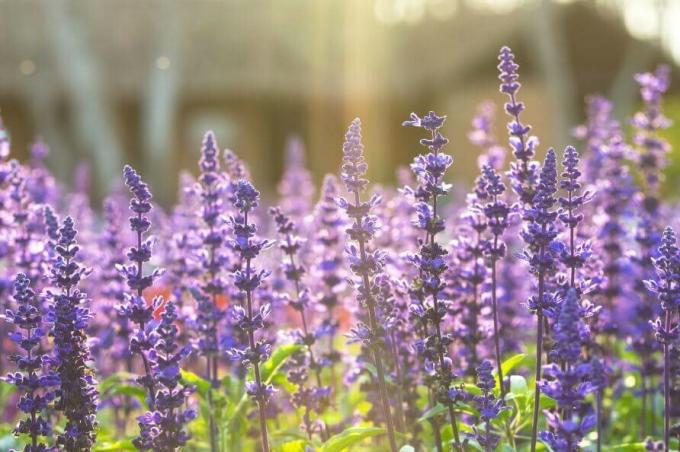
sage (Salvia) belongs, like basil, to the mint family (Lamiaceae). The genus includes numerous species and even more varieties that are used as ornamental plants, spices and medicines. Until a few years ago, only one representative of the sage plant genus could be found in the local gardens: Den garden sage (Salvia officinalis). Only through a few highly specialized and well-stocked herb nurseries have other species found their way into our gardens. The optical diversity ranges from vigorous varieties to compact ones, from single-colored to multicolored, to varieties that do not flower at all. This wide range of shapes, colors and possible uses makes a deeper insight into the world of sage, rich in species and varieties, extremely worthwhile.
contents
- Sage species: history and overview
-
Types of sage for the kitchen
- Fruit sage (Salvia dorisiana)
- Garden sage (Salvia officialis)
- Honeydew melon sage (Salvia elegans)
- Pineapple sage (Salvia rutilans)
- Peach Sage (Salvia greggii)
-
Sage as a remedy
- Clary Sage (Salvia sclarea)
- Meadow sage (Salvia pratensis)
-
Ornamental Sage: Eye-catching and colorful species for the garden
- Peruvian sage (Salvia discolor)
- Currant sage (Salvia microphylla)
- Fire sage (Salvia splendens)
- Meal Sage (Salvia farinacea)
-
Scented sage: The best types for the incense pot
- Cleveland Sage (Salvia clevelandii)
- Indian smoked sage (Salvia apiana)
- Hardy Sage: These species and cultivars survive the cold
Sage species: history and overview
Countless medically relevant ingredients have been confirmed for the approximately 900 species of sage that exist worldwide. Hence the genus name Salvia, which is derived from the Latin word "salvare", which means "to heal". Since the Middle Ages, common sage (Salvia officinalis) used by us for this purpose - but also as a spice and alcoholic preparation. Many other species have already been used for similar purposes in different parts of the world used - such as in traditional Chinese medicine - before coming to us were introduced. And some species simply have a particularly high ornamental value. The color spectrum of the sage blossoms ranges from classic blue to violet, through orange and pink to an intense scarlet. Below we present the most popular types and varieties of sage, depending on their use.
Types of sage for the kitchen
Sage is used as a spice in many countries and in countless dishes. The young leaves, in fresh or dried form, are mainly used for this. But the flowers can also be eaten with many species and, in addition to the taste, give a colorful accent to salads and other dishes. Depending on the type and variety of sage, the aroma of the herb differs and can therefore be combined with many different spice palettes.
fruit sage (Salvia dorisiana)
The fruit sage from Central America loves warmth and light. This fruity, fragrant sage attracts many garden lovers to buy it, but you should first make sure that you can offer the plant a bright and warm winter quarters. A conservatory is best suited for this. If these requirements are met, you will be rewarded with a wonderful aroma. Because the fruit sage smells of ripe melons and other tropical fruits. The leaves and flowers are ideal for use in desserts, summer salads and fruit teas.
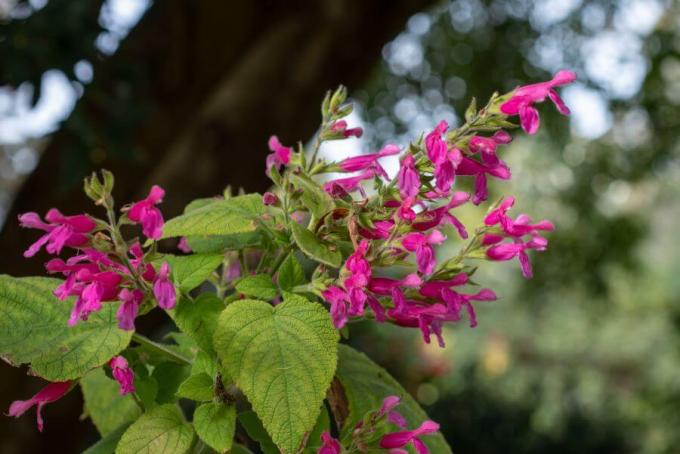
Spice and garden sage (Salvia officialis)
Garden sage or real sage, which we often call simply sage, is one of the most popular kitchen herbs. It gives dishes like gnocchi or saltimbocca a Mediterranean touch. Most varieties of garden sage are hardy in a sheltered location. However, you should protect the plant with some fleece or brushwood. Varieties with multicolored leaves are usually not sufficiently hardy and should only be planted in wine-growing regions. However, a culture in a bucket with subsequent overwintering (garage, gazebo, etc.) is possible without any problems. A selection of the best garden sage varieties can be found here in our special article.
honeydew melon sage (Salvia elegans)
Honeydew melon sage is often mentioned in the same sentence as pineapple sage. Many hobby gardeners even assume that these are synonyms. Unlike the pineapple sage (Salvia rutilans) smells the Salvia elegans especially after other tropical fruits like melon, papaya or guava. You may also recognize pineapple notes, which we can only perceive marginally. The species of sage, which is native to Central America, makes similar demands on its location as the fruit sage and needs a bright and warm place to overwinter. Due to its fruity note, honeydew melon sage is particularly good in teas and desserts. A particularly popular variety is the honeydew melon sage 'Mello', which impresses with its intense melon scent, bright red flowers and easy care.
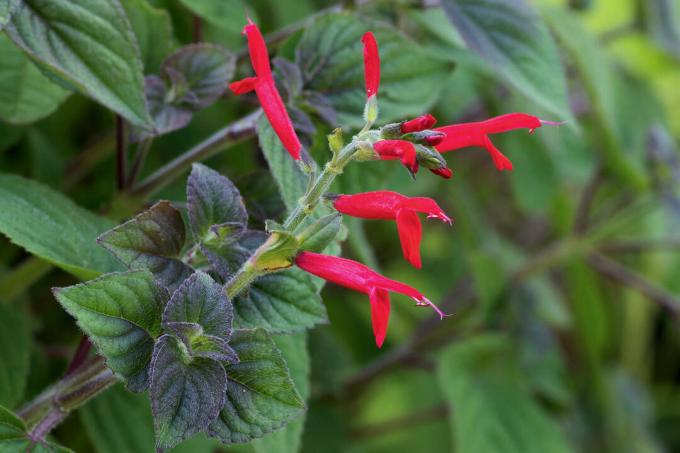
pineapple sage (Salvia rutilans)
The pineapple sage looks like the honeydew melon sage (Salvia elegans), with its bright red flowers, very similar; impresses with an intense pineapple aroma. Both the leaves and the flowers can be used in the kitchen, the latter being sweet, contain fragrant nectar, and are therefore used as an ideal fragrance and decoration in desserts be able. The pineapple sage also has a small advantage over the honeydew melon sage: it is hardy and can therefore be kept in the garden all year round without any problems. The most well-known and commercially most common variety of pineapple sage is appropriately named 'Pineapple Scarlet'.
peach sage (Salvia greggii)
The species, also known as autumn sage, cannot be precisely determined from its origin. Depending on the source, North or Central America is assumed to be the region of origin. The literature on frost tolerance is also divided. While there is some talk of good winter hardiness for most German regions, specialized herb nurseries are happy to refer to instructions for frost-free overwintering. This should be done in a cool place at 5 – 12 °C. The effort of overwintering is definitely worth it. The leaves and flowers smell wonderfully of peaches, apricots or ripe plums. Either you brew the parts of the plant to make a slightly fruity tea or add young leaves and flowers to desserts or fruit salads. Popular varieties are 'Maraschino' and 'Variegata' with bright red flowers, or 'Dark Violett' with dark purple flowers.

Sage as a remedy
Sage is used medicinally in many parts of the world. However, not all types have medically relevant ingredients and those that have been proven to have healing powers differ greatly in their effects. Also the previously presented garden sage (Salvia officinalis) has been used as a medicinal plant since the Middle Ages. It has an antibacterial and anti-inflammatory effect and can therefore be used to treat sore throats and sore throats, as a tea or broth for gargling. The real sage also has a digestive effect and therefore makes hearty dishes not only wonderfully spicy, but also more digestible.
clary sage (Salvia sclarea)
This sage species has been cultivated in the Mediterranean since ancient times. A few centuries came while the Romans used the dried leaves for headaches Later, resourceful winegrowers came up with the idea of inferior wine with a decoction of clary sage "to upgrade". Whether this also helps against headaches remains doubtful. In any case, the sage species known as a pasture for bees and butterflies does well in your own garden. Before flowering, the sticky leaves can be harvested. They are added fresh to drinks such as water for flavoring. The leaves are also good in desserts.

meadow sage (Salvia pratensis)
The meadow sage originally comes from the Mediterranean region, but nowadays it is also native to us and large parts of Europe. Nevertheless, it still loves warm and dry locations and thrives particularly well on calcareous soil. Meadow sage is great for framing a natural garden, as it is a real magnet for native insects such as butterflies, bumblebees and other bees. The healing effect of meadow sage is similar to that of garden sage, but slightly weaker. The herb can be used against inflammation and also has an antiperspirant effect, which is why it can also be used for menopausal symptoms such as hot flashes. The different varieties of meadow sage also produce beautiful flowers in different shades and have appropriate names such as 'Snow Lake', 'Pink Delight' or 'Indigo'.

Ornamental Sage: Eye-catching and colorful species for the garden
Not all types of sage have healing powers or are particularly suitable for consumption. That doesn't make them any less interesting, however. The genus Salvia impresses with its great variety of species and varieties, which contains some real beauties. Sage is therefore just as valuable as an ornamental plant as it is as a medicinal and spice plant. Below we present a selection of magnificent types of sage that enrich your garden with bright colors and sometimes beguiling scents.
Peruvian sage (Salvia discolor)
As the name suggests, is Salvia discolor based in South America. Its origin is believed to be in Peru. Due to its beautiful appearance, this sage is mainly cultivated for ornamental purposes. However, stems and leaves can be smoked or brewed into teas. The dark violet flowers taste slightly sweet and are ideal for decorating desserts. In contrast to the garden sage, this sage representative is not hardy and must be overwintered in a cool place.
currant sage (Salvia microphylla)
As a further rarity, the blackcurrant sage should not be missing in any sage collection. The aroma is strongly reminiscent of intensely spicy currants. So, unsurprisingly, this herb is best used in fruit salads or desserts. You can also use the leaves to infuse teas, but other types of sage are better here. The bright red flowers also enchant every balcony and every flower bed. This sage species is also not hardy and should be overwintered at 5 - 10 °C. The best-known variety of currant sage is the hybrid form 'Hot Lips', obtained by crossing with the peach sage (Salvia greggii) was created.
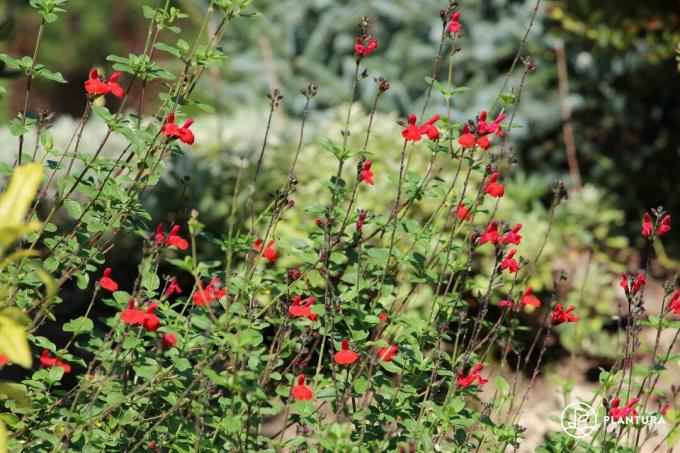
fire sage (Salvia splendens)
Even if the original fire sage was said to be several meters high, today's cultivated forms reach a maximum height of one meter. Especially the small varieties, like the two-tone one 'Unica Red & White', which reach a maximum of 20 cm, are popular eye-catchers in flower beds, pots or balcony boxes. Other color miracles are the varieties 'Scarlet King', which bloom in a bright red, or 'St. John's Fire', which are of a darker but no less intense red. However, the species from Brazil does not tolerate cold temperatures and is therefore not hardy in our country.
flour sage (Salvia farinacea)
Another very popular ornamental plant is the mealy sage or mealy sage. The herb gets its name from the blue to white, fine hairs on its inflorescence axis, which leaves a pollinated impression. Depending on the variety, the color spectrum of the flowers themselves varies between deep blue, as in 'Blue Bedder', and blue-violet, as in 'Victoria'. A special eye-catcher is also the variety 'Strata' with a mixture of white and blue flowers. Unfortunately, the common sage does not survive the winter outdoors. However, specimens planted in a pot can overwinter at room temperature if there is sufficient light.

Scented sage: The best types for the incense pot
Sage has an incomparable scent that becomes even more apparent when lit. The herb is therefore dried in many cultures and used as incense. It's not just about the mystical appearance of the smoke, but also about its cleansing effect. For example, houses contaminated by disease, such as after a measles infestation, were smoked out with sage to disinfect them.
Cleveland sage (Salvia clevelandii)
A popular smoked sage for cultivation in Germany is Salvia clevelandii. Even though Cleveland is in the US state of Ohio, this sage species is particularly found in California. Consequently, the plant can also be planted in dry and very hot locations. In contrast to the Indian smoked sage is Salvia clevelandii less sensitive to moisture. In our climate, this species of sage definitely needs to be overwintered in a frost-free place. The shoots are used for smoking. Gloves should be worn when harvesting, as the plant can leave a very intense odor on the skin.
Indian smoked sage (Salvia apiana)
has his name Salvia apiana received from the native peoples of North America. They used the incense sage for ceremonies and rituals. The species from California tolerates drought and heat very well. However, wetness is poorly tolerated. Watering the plant just a few times too much can already damage it. Before smoking, the resinous stems and leaves are dried. The Indian smoked sage is not hardy with us and must be overwintered in a cool place. In terms of brightness, it makes significantly lower demands than honeydew melon or fruit sage.
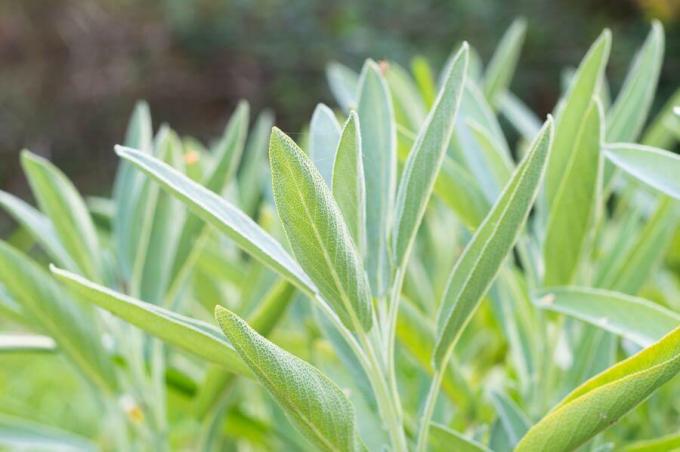
Hardy Sage: These species and cultivars survive the cold
Not all sage species and varieties are adapted to our cold seasons and must therefore be brought indoors with the onset of winter. Bright, light-flooded rooms with large windows or even a conservatory are ideal. It is therefore advisable to keep these plants in a pot all year round to make moving easier. We have compiled the following list for you of those species that you can easily plant in the garden without having to worry about frostbite. But be careful: there are differences here too. Some varieties are declared as "hardy", but can still suffer permanent damage in very harsh winters. For these species, it is advisable to cover the perennials with brushwood or foil. The slightly more sensitive species are marked with an asterisk (*) in the list below.
The following sage species and varieties are hardy:
common sage (Salvia officinalis)
- silver sage (Salvia officinalis 'culinaria')
- dwarf sage (Salvia officinalis 'nana')
- Crimson Sage (Salvia officinalis 'Purpurascens')
- Tricolored Sage (Salvia officinalis 'Tricolor')*
- Yellow-green sage (Salvia officinalis 'icterina')*
Pineapple Sage (Salvia rutilans)*
Yellow Sage (Salvia glutinosa)
steppe sage (Salvia nemorosa)
meadow sage (Salvia pratensis)
- Salvia pratensis haematodes 'midsummer'
- Salvia pratensis 'Pink Delight'
- Salvia pratensis 'Indigo'
- Salvia pratensis 'Snow Lake'
Whorled Sage (Salvia verticillata)
If you've got the gardening bug and you want to enjoy the many benefits of sage in your own garden, you should also choose the right substrate for your plants. To give your sage the best possible start in your herb bed, we recommend ours Plantura Organic Herb & Seed Soil. This peat-free soil, made from 100% natural raw materials, not only offers optimal conditions for your herbs, but is also good for the environment.
And before you even get your hands on the shovel, take a moment to learn how exactly you do it in our next feature article Grow sage properly.



